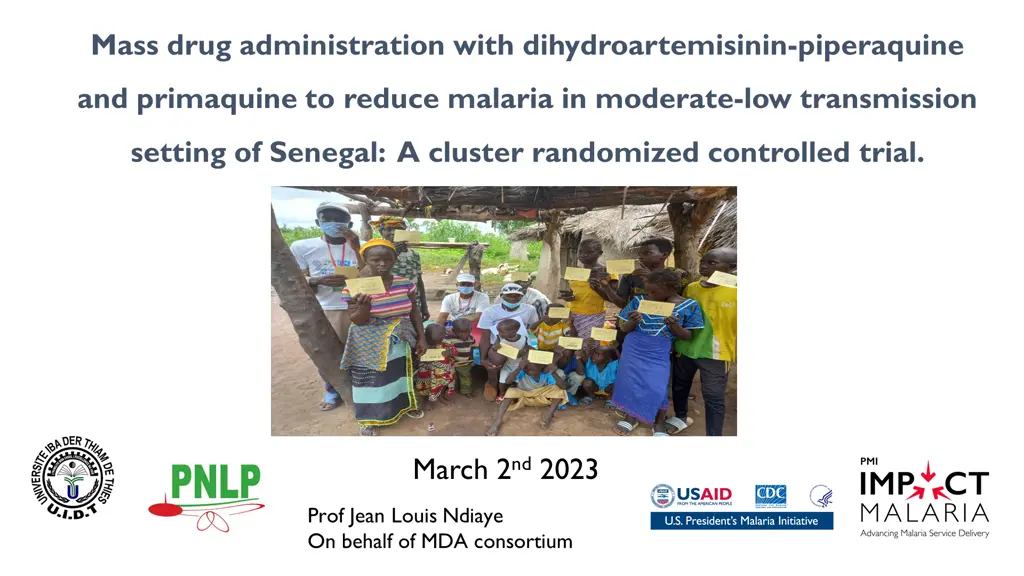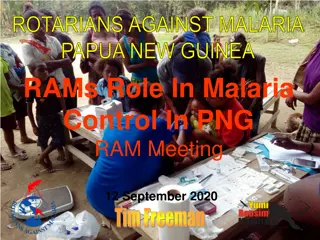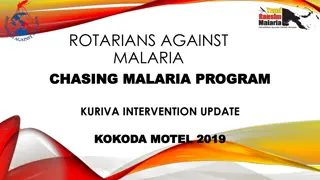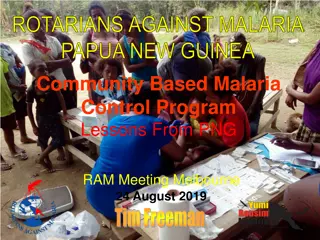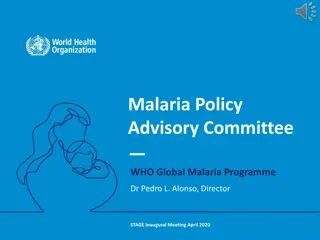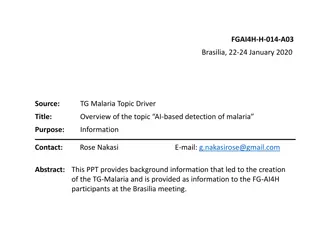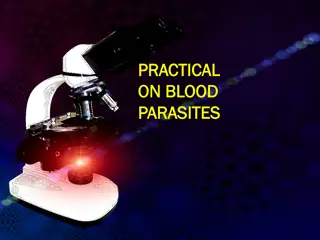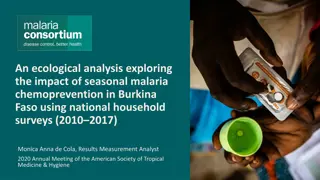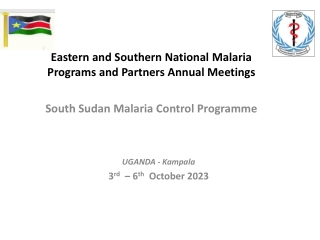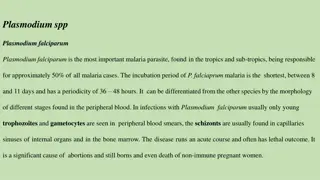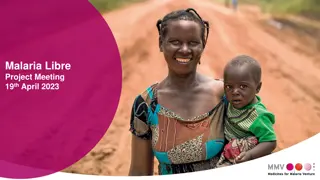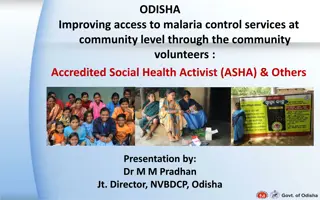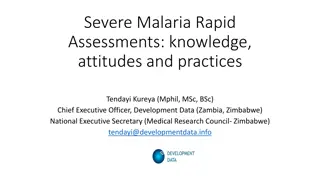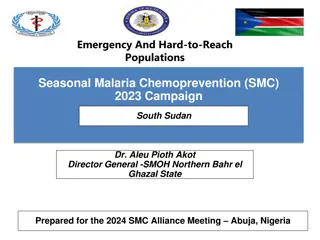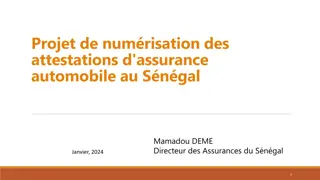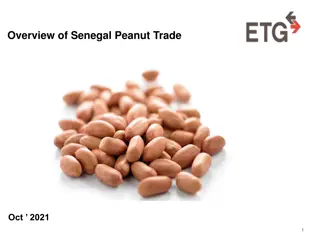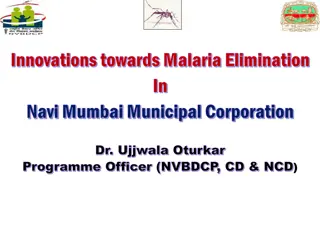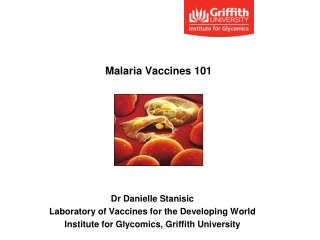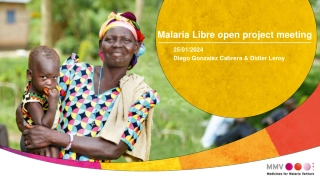Optimizing MDA for Malaria Reduction in Senegal
Study on mass drug administration with dihydroartemisinin-piperaquine and primaquine in Senegal to reduce malaria transmission. Senegal's progress in malaria reduction, seasonal transmission, and comparison of SMC vs. MDA strategies. WHO recommendations and testing a hypothesis for sustainable impact.
Download Presentation

Please find below an Image/Link to download the presentation.
The content on the website is provided AS IS for your information and personal use only. It may not be sold, licensed, or shared on other websites without obtaining consent from the author. Download presentation by click this link. If you encounter any issues during the download, it is possible that the publisher has removed the file from their server.
E N D
Presentation Transcript
Mass drug administration with dihydroartemisinin-piperaquine and primaquine to reduce malaria in moderate-low transmission setting of Senegal: A cluster randomized controlled trial. March 2nd2023 Prof Jean Louis Ndiaye On behalf of MDA consortium
Malaria in Senegal Malaria incidence in Senegal 2000-2020 Senegal has made significant progress in reducing its malaria burden 78% reduction in incidence since 2000 Elimination goal by 2030?? 350 300 306 250 274 IPTp+ACT 200 224 RDTs+PECADOM+IRS 203 SMC CUMILDA 150 PECADOM+ 139125 121 100 99 50 69 66 62 60 53 52 52 50 49 46 41 39 0 33 Malaria transmission is seasonal North = lower transmission:prioritizes pre- elimination activities Case investigation + RACD 200020012002200320042005200620072008200920102011201220132014201520162017201820192020 Southeast = moderate-high transmission:prioritizes control activities SMC, community case management [PECADOM+], LLINs KKT region counting more than 80% of malaria cases and deaths
Chemoprevention strategies SMC versus MDA SMC in Senegal Used as a burden reduction approach only for children under 10 No impact on transmission parasite reservoir is not targeted. Need an alternative approach to further reduce burden MDA considered by NMCP Feasible approach given door to door delivery infrastructure, community acceptance MDA vs SMC is a priority outlined in new 2022 WHO treatment guidelines
WHO recommendations- use of MDA WHO recommends use of MDA in: MDA can be given in areas of moderate to high transmission of P. falciparum to provide short-term reductions in disease burden. WHO supports the need for more research on the optimum methods of implementing MDA programs and evaluating their effectiveness. Modelling can help guide the optimum method of administering MDA in different epidemiological circumstances and predict its likely impact
Hypothesis to test Time-limited MDA with dihydroartemisinin-piperaquine (DHA-PQP) and single, low-dose primaquine in the context of optimized control (effective net, proactive community case management, and SMC) can reduce transmission of Plasmodium falciparum in moderate-low transmission settings sufficiently that the program can switch to case-based response post-MDA to sustain its impact.
Study Objectives 1. Compare impact of MDA versus SMC on village-level malaria incidence during the implementation and post-MDA year period 2. Determine whether more MDA villages reach a target parasite incidence (<5 cases/1000) compared to SMC villages 3. Compare impact of MDA versus SMC on parasite prevalence, drug resistance, and parasite diversity 4. Determine acceptability and cost-effectiveness of MDA compared to SMC
Study design 523 villages screened Cluster RCT 60 villages Villages were excluded if population under 200 and over 800 Ensured a 3 km buffer zone between study villages 412 villages excluded 111 villages met the inclusion criteria 60 villages randomized (n=20,382 individuals) 523 villages ? 111 were eligible for inclusion ? 60 were randomly selected such that a 3km buffer zone existed between study villages 30 villages randomized to MDA (n=10,572 individuals) 6,506 individuals received R1 7,125 individuals received R2 7,256 individuals received R3 30 villages randomized to SMC (n=3,747 individuals) 2,702 individuals received R1 2,974 ndividuals received R2 3,071 individuals received R3
Study design Intervention = 3 rounds DP+SLD-PQ to individuals of all ages Control = SMC to children <10 Participant ineligibility criteria pregnant women/self-reported illness/allergy to study drugs
Study site Conducted in Tambacounda Health district Optimized malaria control setting PBO nets distributed in the prior to season Active case detection (weekly sweeps); 1-2 CHWs/village depending on village size Malaria prevalence was ~ 6,8% across 60 villages (min=0, max= 30%) Average malaria incidence was 387 cases/1000 person-year
Study timeline July-Dec: transmission season Malaria morbidity data collection Baseline survey, Dec 10-20 Endline survey, Dec 9-21 PBO net distribution, Nov 2020 Year N+1 follow up Census 2, Nov 2020 Census 1, Feb 2021 Jan 1, 2021 Jan 1, 2022 Jul 1, 2021 Jul 1, 2020 Jan 1, 2020 Jan 1, 2023 Jul 1, 2022 2021 MDA campaign (intervention) Round 1: Jun 21-25 Round 2: Aug 6-11 Round 3: Sept17-21 2020 SMC campaign (all villages) Round 1: Jul 24-27 Round 2: Aug 31-Sept 3 Round 3: Sept 30-Oct 3 2021 SMC campaign (control) Round 1: Jul 30-Aug 3 Round 2: Aug 27-30 Round 3: Oct 1-4
Study procedures Community engagement activities occurred before and during MDA Top down meetings with: Health authorities in presence of NMCP Head of villages with local health authorities Head of households in presence of head nurses Women in reproductive age in presence of Midwifes Home visits ICs was taken before round 1 for all 3 rounds Trainings done with CHWs and HF nurses on protocol, drug distribution, and quality of malaria surveillance data collection.
Study procedures MDA delivered door to door DOT for all 3 doses of DHA-PQ and single PQ dose Focus Groups Interviews and direct observation Active and passive surveillance used to monitor for adverse events Adverse events followed up to resolution Pregnancy testing for women between 13 and 49 YO (each round) Sensitization campaigns before each MDA round Supervision visits in all villages
Baseline Characteristics Characteristics Village-level Number of clusters By health post, n (%) Bohe Dar Salam Dawadi Koussanar Missirah Neteboulou Sinthiou Maleme Presence of DSDOM prior to the study, n (%) No Yes Distance to health post in km, mean (SD) Population size in 2019, mean (SD) Population size <10 years of age in 2019, mean (SD) Baseline microscopy prevalence (%), mean (SD) Total MDA SMC 60 30 30 9 (15%) 2 (3%) 14 (23%) 9 (15%) 6 (10%) 5 (8%) 15 (25%) 6 (20%) 1 (3%) 6 (20%) 5 (17%) 2 (7%) 2 (7%) 8 (27%) 3 (10%) 1 (3%) 8 (27%) 4 (13%) 4 (13%) 3 (10%) 7 (23%) 20 (33%) 40 (67%) 14.8 (8.4) 322 (168) 119 (62) 8% (8) 10 (33%) 20 (67%) 14.9 (8.6) 330 (170) 120 (63) 7% (9) 10 (33%) 20 (67%) 14.6 (8.3) 315 (168) 117 (62) 9% (8)
Coverage High MDA and SMC coverage; many MDA villages hadcoverage 80%. MDA DistributionalCoverage ~80% of participants receivedat least 1 dose in rounds 1, 2, and 3 Variabilitybetweenvillages SMC Distributionalcoverage >90% of participants receivedat least one dose of SP-AQ in rounds 1, 2, and 3 Reasonsfor not takingmedication: Absence (13-21%) Refusal(1-2%)
MDA reduced malaria incidence by 53% compared to SMC MDA resulted in a 53% [95% CI: 29%, 69%] reduction in clinical malaria incidence compared to SMC between 2020 and 2021.
Effects on clinical malaria incidence were greater in those 10+ years Subgroup analysis Adjustedeffect < 10 years of age 43% [13%, 63%] 10 years of age 59% [37%, 74%]
SubgroupAnalysis by Baseline Incidence Baseline API < 250 Baseline Incidence <250 (n=21 cluster MA, 18 cluster SPC) Intervention effect = 18% [-34%, 50%] Increases from 2020-2021 onwards are likely to be due to improved case management through DSDOM capacity building. 19/20 of villages without a baseline DSDOM included in this analysis. Baseline API 250 Base incidence 250 (n=9 WMAs, 12 CPSs) Intervention effect = 70% [19%, 75%] Note that the incidence in the graphs is for the July-Dec transmission year.
Parasite Prevalence by microscopy and qPCR Similar trends observed in parasite prevalence results Prevalence confirmed by microscopy Effect of intervention = 62% [22%, 81%]. Parasite prevalence confirmed by PCR Effect of intervention = 43% [-4%, 69%].
Prevalence of resistance molecular markers MDA SMC Mutations Baseline Endline Baseline Endline PfK13 C580Y PfDHPS K540E A437G A581G PfDHFR N51I C59R S108N PfCRT K76T PfMDR1 N86Y Y184F No strong evidence of resistance selection by the MDA or SMC. The K13 C580Y mutation is observed at a very low prevalence (0-2%). No evidence of the PfDHPS K540E mutation; PfDHPS A581G mutation prevalence observed at 0-0.8%. 2% 0% 0% 0% 0% 81% 0.8% 0% 87% 0% 0% 81% 0% 0% 87% 0% 98% 100% 32% 100% 100% 23% 98% 100% 39% 100% 100% 29% 38% 36% 46% 44% 5% 66% 0% 64% 2% 81% 0% 65%
Prevalence of AEs (active surveillance) in children <=10, round 3 MDA arm 14 (4.1%) 2 (0.6%) 3 (0.9%) 1 (0.3%) 2 (0.6%) 1 (0.3%) 2 (0.6%) SMC arm 7 (1.4%) 2 (0.4%) 0 0 0 0 2 (0.4%) p value 0.024894 0.72995 0.997 0.998 0.997 0.998 0.72995 Fever Headache Abdominal pain Drowsiness Nausea Cough Influenza like illness
Safety -Passive surveillance MDA SMC Passive surveillance Participants with any AE, n/N (%)1 All rounds/cycles First round/cycle Second round/cycle Third round/cycle Frequency of adverse events, n All rounds/cycles First round/cycle Second round/cycle Third round/cycle Most common adverse events, n/N (%) Headache Abdominal pain Vomiting Fever Other 67/20,887 (0.3%) 46/6,506 (0.7%) 13/7,125 (0.2%) 8/7,256 (0.1%) 73/9,522 (0.8%) 33/3,202 (1.0%) 40/3,174 (1.3%) 0/3,146 (0%) 129 97 20 12 99 40 59 0 33/129 (25.6%) 25/129 (19.4%) 23/129 (17.8%) 22/129 (12.1%) 26/129 (20.2%)
Acceptability Participant perceptions of MDA improved over rounds due to perceived reduction in malaria cases, added benefit of malaria prevention for adults, and less bitter taste of drugs. Active engagement by trusted political and health leaders in the community. Authorities set an example by actively taking drugs in front of community and encouraging community to accept the drugs. Utilization of experiences and lessons learnt from SMC and other MDA campaigns to improve coverage. Teams began drug distributions early in the morning before participants left to the field adapting their strategies to the local constraints Participants were contacted via phone and reached in remote locations to deliver drugs
Reasons for non coverage Cultural and religious events (e.g., weekly markets, traditional and religious ceremonies) were strong influencers of absences. Agricultural and livestock season resulting in many absences among community Several participants intentionally were absent during the campaign or reported a self-reported pre-existing heart conditions as a strategy to not outwardly refuse MDA. Suspicion that MDA campaign would reduce the fertility and longevity of participants, which were spread through social media campaigns and made worse by negative rumors around COVID-19 pandemic. Videos were shared through social networks to warn their communities about possible risks related to drugs and vaccines during COVID-19 pandemic. Experiences of side effects in previous rounds.
Operational challenges coverage levels were affected by moderate levels of mobility, logistical challenges in accessing remote villages during rainy season Refusals were more common among adolescents and younger adults who were affected by negative social media messaging around COVID-19 and were thus more fearful and/or suspicious about other public health interventions. Diversion of human resources in response to COVID-19 pandemic and other public health interventions (e.g., yellow fever immunizations) caused delays in MDA implementation Pediatric formulation of primaquine required additional time and resources to crush tablets and dissolve in water
Lessons learned Strong support from key administrative and health authorities, including the District Health Officer, health post nurses, village elders and engagement from the existing community health worker system are drivers of Mass campaign success Routine district activities (such as mass vaccination, NTDs chemoprevention ) can negatively impact optimal implementation of MDA Repeated training on drug delivery and dosing guidelines helped to ensure efficient delivery of MDA It is necessary to have pediatric formulation of primaquine to better implement MDA using such drug
Conclusion Goodacceptability of MDA despite some challenges High level of coverage No SAEs Senegal plan it s introduction in 2 medical districts in the south region Tailored strategies needs to be anticipated for nomads and extremely mobile persons during transmission season
Next steps 2022 SMC campaign monitoring; Coverage was ~92-100% in study villages. Year 2 moribidity data collection under analysis to see if effets were sustained in follow-up year. Lab analysis drug resistance markers, serology Cost effectiveness analysis Dissemination to communities planned for May 2023 Plan of NMCP is to do MDA in 2 districts
Acknowledgements Impact Malaria Michelle Hsiang Roly Gosling Michelle Roh Kyle Daniels Moustapha Hama Cara Smith-Gueye Tabitha Kibuka Adam Bennett Xu We Thierno Ba Elhadj Ba Abdoulaye Diallo Elhadji Diouf Amadou Seck Aminata Colle Lo Ndeye Fatou Lo Sylla Thiam RM Tamba Bayal Ciss Tidiane Gadiaga PNLP Fatou Ba Latsouk G. Diouf Ibrahima Diallo Elhadji Doucoure Standeur N Kaly Seynabou Gaye Medoune Ndiop Doudou Sene UCAD Cheickna C S Diawara Kadiatou Dieng Tidiane Ndoye Mouhamadou M. Pouye Seynabou Sakho PMI Senegal Mame Birame Diouf Alioune Badara Gueye Katherine Sturm-Ramirez UIDT Thi s PMI CDC Jimee Hwang Leah Moriarty Julie Thwing LSHTM Ari Fogelson Paul Milligan VECTOR LINK Jean Biyik Abdoulaye Diop CIGASS Yaye Di Dia Daouda Ndiaye Abdoulaye Tine
